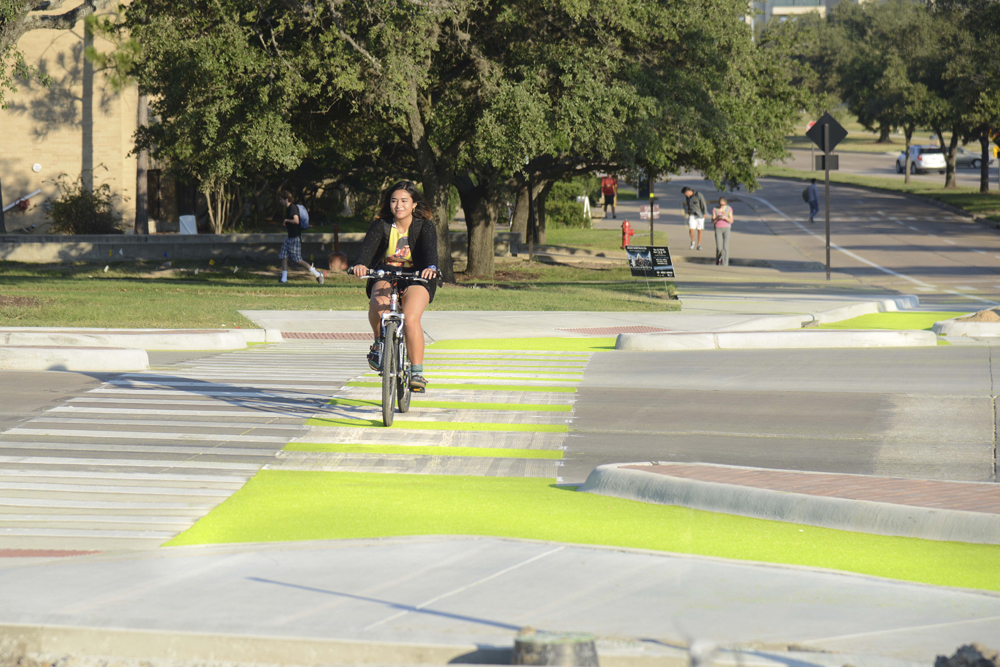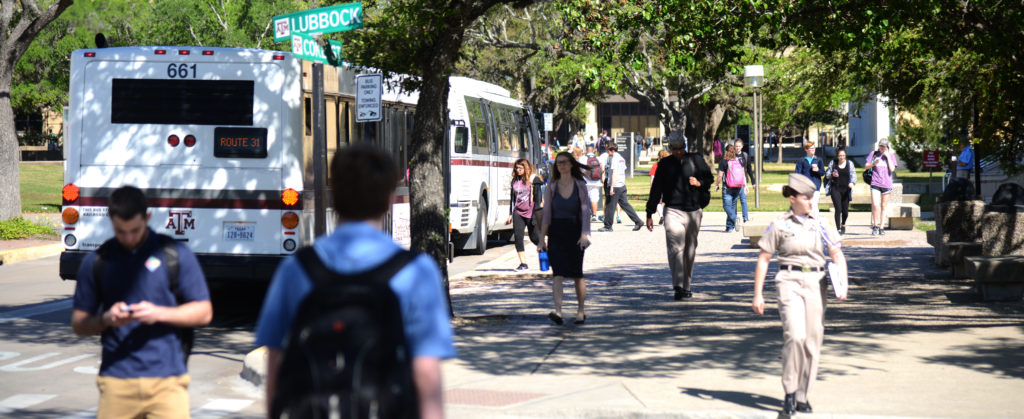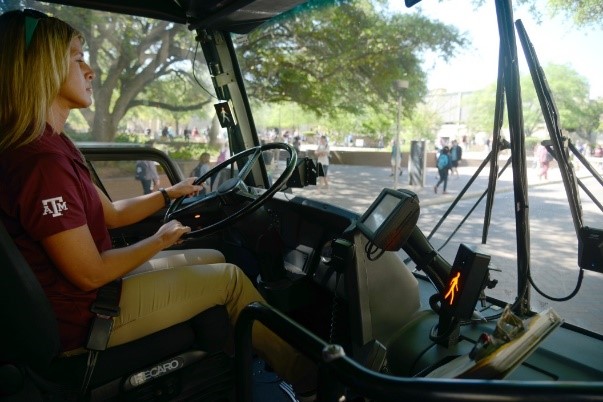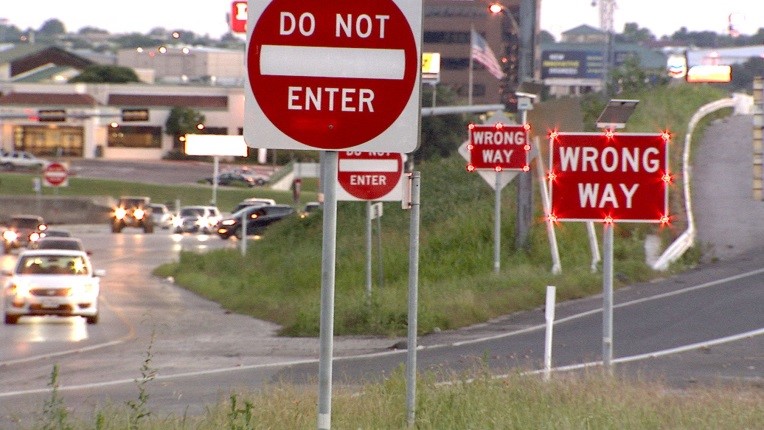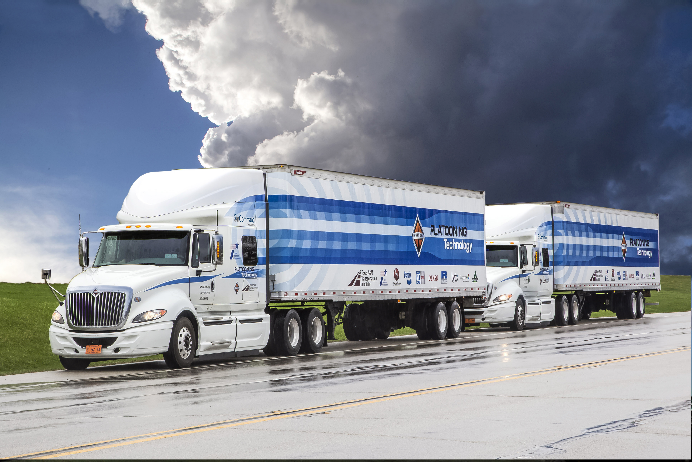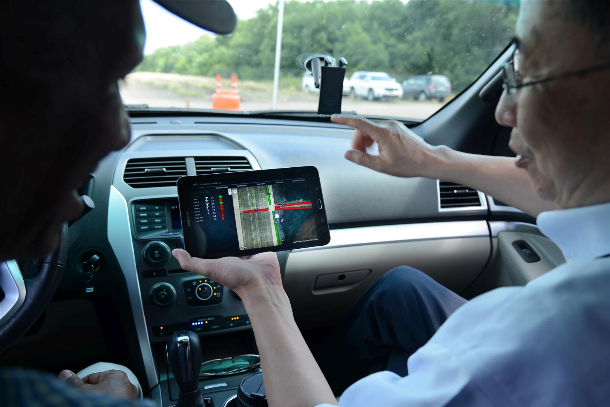On this page
Solar luminescent pavement markings.
#BicycleSafety / #Campus
In 2016, Texas A&M Transportation Services reconstructed the intersection of Bizzell and Ross Streets, an unsignalized on-campus crossing with high pedestrian, bicycle, and vehicle volumes. The project also realigned a parking lot entrance and features the first Texas A&M implementation of a Dutch junction. The Dutch junction, developed in the Netherlands and refined in other locations, moves bicyclists in front of vehicles at the intersection, increasing the protection for cyclists. The key to its design is the islands at the intersection corners. They separate cars and cyclists turning right; they also move cyclists traveling straight into the view of automobiles and away from their blind spot.
Green paint has been used to illustrate the bicycle pathways. In this innovation, an illuminating green pavement marking keeps the pathways lit for the cyclists by storing solar energy during the day and emitting light during nighttime.
For more information, contact Bob Brydia at [email protected].
The press release on the Dutch Junction Unsignalized Intersection installed on the Texas A&M Campus in the fall of 2016 was the most read story of the year in Texas A&M Today. Texas A&M Today goes out once a week to 70,000 subscribers, including all Texas A&M faculty, staff and students, as well as members of the media who subscribe.
TTI, EPA team up with transportation services to analyze Texas A&M transit fleet performance
#Transit / #Campus
TTI, in cooperation with the U.S. Environmental Protection Agency (EPA), recently kicked off a project to study the drive cycles of the Texas A&M University fleet buses that serve the campus and surrounding areas. The agencies are working together through a cooperative research and development agreement (CRADA).
The research team will use portable activity measurement system (PAMS) devices plugged into 15 vehicles that will monitor the engine (speed, RPM, load, and other parameters) data along with GPS information in order to analyze the bus fleet drive cycles, and identify characteristics such as idle time and speed distribution. The PAMS loggers are small devices that plug into the vehicle and gather information that is being broadcast by the engine.
For more information, contact Joe Zietsman at [email protected].
Read the related article from the TTI website.
Transit Shield+ pedestrian collision warning system.
#Transit / #Campus
In spring 2016, TTI researchers worked with Texas A&M Transportation Services to install and evaluate the Mobileye Shield+ pedestrian collision warning system on an existing Texas A&M bus. The Mobileye system uses three different cameras and advanced machine vision algorithms to monitor the bus driver’s blind spots, where pedestrians and bicyclists are most likely to show up in harm’s way. The evaluation was part of a larger research project funded by the Texas Department of Transportation (TxDOT) using automated and connected vehicle technology to improve transit, pedestrian, and bicyclist safety.
The Texas A&M bus equipped with the Shield+ collision warning system was put into operation on the Bonfire Route, which travels through some of the most congested parts of the campus. TTI gathered extensive data over a two-month period to assess the performance and accuracy of the system. TTI found the collision warning system operated as intended, identifying pedestrians and bicyclists that were in close proximity to the equipped bus. The evaluation also showed Mobileye several potential areas of improvement for its system.
For more information, contact Shawn Turner at [email protected].
Connected vehicle wrong-way driving detection and mitigation demonstration.
#ConnectedVehicle / #RELLIS
TTI and the Southwest Research Institute are working with TxDOT to develop CV applications that will detect wrong-way vehicles, notify traffic management agencies and law enforcement, and alert affected travelers. The research team reviewed the state of the practice regarding intelligent transportation systems and CV technologies being applied as wrong-way driving countermeasures. The research team identified user needs associated with the implementation of a CV wrong-way driving system, assessed motorist understanding of wrong-way driver warning messages posted on dynamic message signs, and ascertained preliminary ways to connect with law enforcement. Phase 1 culminated in the development of a concept of operations, functional requirements, and high-level system design for a wrong-way driving applications CV test bed.
In Phase 2, the research team is developing a proof-of-concept CV wrong-way driving detection and management system at The Texas A&M University System RELLIS Campus. The test bed will provide an off-roadway, closed-course facility to develop and fine-tune the system components and operations prior to installing them on an actual roadway. The research team will also conduct human factors studies to investigate the information needs of right-way drivers when a wrong-way driving event occurs. Phase 3, if funded, would include the implementation and evaluation of a CV wrong-way driving system in at least one location in association with TxDOT.
For more information, contact Melisa Finley at [email protected].
Commercial truck platooning — Level 2 automation.
#AutonomousVehicle / #RELLIS
Private-industry partnerships and funding from TxDOT’s innovative research program are being combined by TTI to create a first-of-its-kind comprehensive freight platooning demonstration in Texas. The TTI team will use what it has learned from past and current platooning research projects to demonstrate the safety benefits, fuel savings, and emission reductions achieved by automating freight truck platoons.
The project is being conducted in three phases:
- Phase 1: Conduct a feasibility planning study and proof-of-concept demonstration.
- Phase 2: Develop the concept of operations and design requirements.
- Phase 3: Deploy a commercial truck platooning application in Texas.
The TTI team investigated lessons from past platooning projects, identified potential regulatory or legislative roadblocks that could hamper introduction of platooning into commercial fleet operations, and explored the possible business cases and implementation scenarios within the existing infrastructure and operational environment. The TTI team also developed, tested, and demonstrated the proof-of-concept platooning technology, which will culminate in a full-scale Demonstration Workshop on July 22 at the RELLIS Campus in Bryan. The team will disseminate the results; capture insights, comments, and buy-in from stakeholders; and set the stage for further development and deployment.
For more information, contact Beverly Kuhn at [email protected].
New approaches for testing connected highway and vehicle systems.
#ConnectedVehicle / #RELLIS
TTI, the Battelle Memorial Institute, and the Siemens Corporation teamed together to conceive and develop a new plug-and-play platform that FHWA will use to test, validate, and verify CV concepts, applications, and technologies. The platform replicates field deployments in a laboratory testing environment by using a hardware-in-the-loop simulation system to incorporate real vehicles in the simulation model and display simulated vehicles inside the real vehicles. The platform also integrates a communication network simulation with the traffic simulation model to assess the impact of disruptions in communication on the effectiveness of CV applications. The platform allows FHWA to:
- Test and verify proposed mobility-, environment-, and safety-related concepts and applications prior to deployment in the field.
- Quantify potential benefits from running different safety, mobility, and environmental applications in typical operating environments (i.e., traffic volume levels with different levels of GPS availability and quality).
- Examine different physical and logical architecture configurations and system components.
- Examine interactions between connected and non-connected vehicles in different operating environments.
- Examine the fail-safe nature of mobility, environmental, and safety applications.
- Ensure interoperability and backward compatibility of equipment, vehicles, and other devices necessary to enable mandatory safety applications, as well as applications supporting mobility, economic competitiveness, and sustainability.
For more information, contact Srinivasa Sunkari at [email protected].

